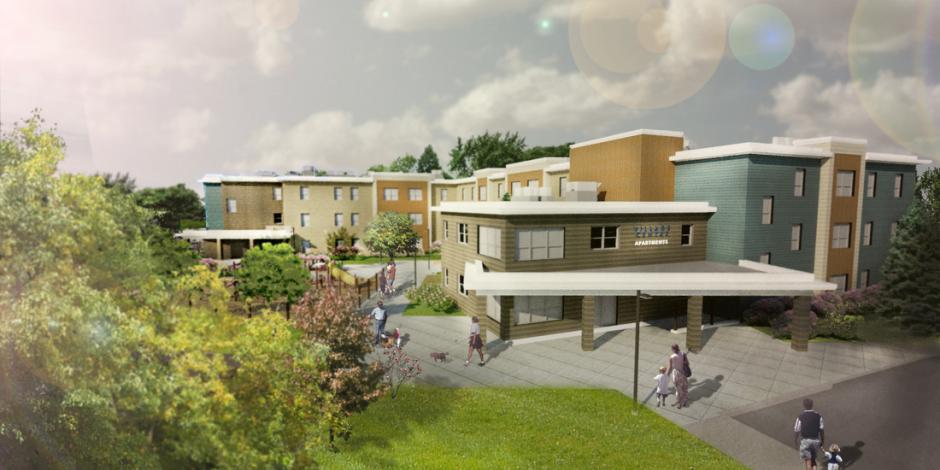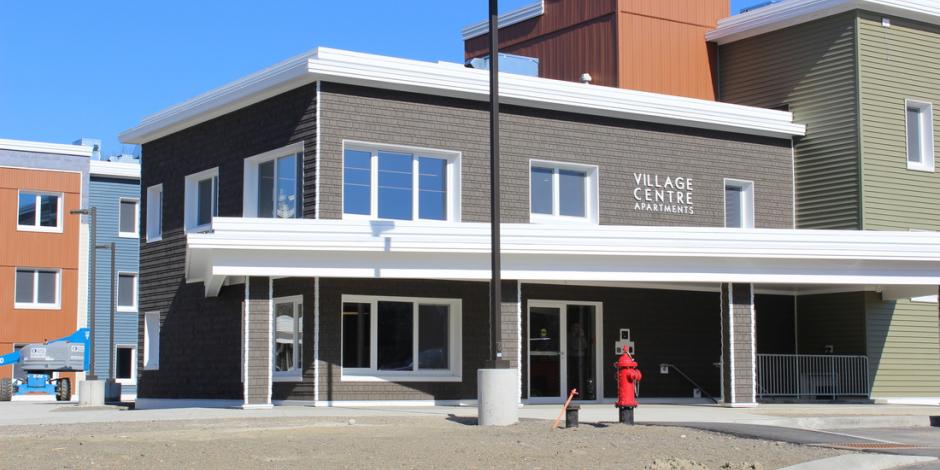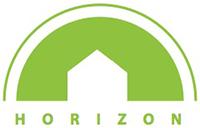- For Professionals
- PHIUS+ Standard
- Case Studies
- Design Guide
- FAQs
- Does Passive Building Cost More to Build ?
- Can Passive Building Scale to Multifamily?
- Are Passive Buildings Resilient?
- Do Passive Buildings Cause Mold?
- What Are the Risks of Passive Building?
- How Long Is The PHIUS+ Certification Process?
- How Much Do Passive House Certifications Differ?
- What About Passive Building HVAC Systems?
Village Centre Apartments, ME
Introduction
Village Centre Apartments located in Brewer, Maine, is one of the largest multifamily passive building projects in North America. Built to the PHIUS+ 2015 Passive Building Standard, Village Centre provides a very comfortable and quiet living environment with even temperatures and excellent indoor air quality throughout.
The building consists of 48 units in a three-story elevator building, comprised of 1, 2, and 3 bedroom affordable apartments with heat and hot water included. Onsite amenities include a sheltered bus stop providing resident access to shopping, schools, and entertainment located within close proximity to the project.
Beginning in mid-2014, Community Housing of Maine (CHOM), CWS Architects, Bennett Engineering, Wright Ryan Construction, and Thornton Tomasetti’s Sustainability Practice set out with the ambitious goal of building Maine’s first large-scale multifamily passive house. This affordable housing project would be located in the challenging climate of Brewer, Maine, a town with over 7,000 annual heating degree days where snowfall in May is not uncommon. In addition to a challenging climate, the project would also be faced with a difficult budget environment and an unconventional design process. As a result of a 2011 controversy over the cost of affordable housing in the State, all affordable housing projects in the state of Maine are subject to a hard cost-cap. These spending limits would force the team to design and permit a conventional building to ensure funding, and then develop creative solutions to meet passive house standards while balancing the budget, operating costs, and lifecycle environmental impact of the project. After passing all of its post-construction on-site testing, Village Centre opened in June of 2016. The project has become a highly-publicized example of the potential for high-performance affordable housing in extreme climates.
Project Data
| Client/Owner | Community Housing of Maine (CHOM) |
| Climate Zone | 6A |
| Size (sf) | 51,778 |
| Levels | 3 |
| Units | 48 |
| Construction Type | Wood frame |
| Walls | Double-stud walls with cellulose infill and Kraft paper vapor retarder (R-37.5) |
| Roof | Polyisocyanurate roof (R-57) |
| Floors | XPS under slab (R-20) |
| Mechanicals | Heating - Electric resistance baseboard, 6 ft. per unit Cooling - Split system, cooling only Ventilation - 16 ERVs (1 ERV serves stack of 3-units) 73% Sensible Recovery |
| Windows | Triple-pane, U-0.18 overall; SHGC 0.47 all non-west orientations; SHGC 0.25 for west orientations; 3" horizontal exterior solar shading on south and west orientations |
Project Team
| CPHC® | Colin Schless | Thornton Tomasetti | |
| Builder | Wright Ryan Construction | |
| PHIUS+ Rater | Diane Schless | Horizon Maine | |
| Developer | Erin Cooperrider | Community Housing of Maine (CHOM) |
Design Solutions
Design Challenges
Brewer, Maine averages over 7,800 Heating Degree days per year, incurring approximately 280% of the heating load of the temperate western European climate for which the initial passive house standard was developed. Thus the project team elected to pursue certification under the climate-specific PHIUS+ 2015 Passive Building Standard.
In January, the average temperature in Brewer is 20°F, with an average of 21 nights dropping below 20°F and 57 days where the temperature is below freezing. Brewer’s lowest recorded winter temperature was -32°F and measureable snowfall occurs in May about once every 4 years. After winter ends, the area quickly becomes warm and humid. June through September is muggy, with select days peaking over 100°F. Brewer demands work from its buildings to keep people comfortable, and doing this work passively would prove an even greater challenge.
Additionally, the team would have to achieve passive standards at little or no extra cost compared to a typical budget for an affordable housing development in Maine. In response to the State's 2011 housing controversy, Village Center was forced to submit a design and budget for a conventional (code) building in order to receive a permit and funding. With a fixed design, orientation, and budget in-hand, the project team set out to achieve the PHIUS+ 2015 standard.
Design Solutions – Site
Unfortunately due to the nature of Maine State Housing Funding, the project was sited, budgeted, and largely designed before passive building considerations came into play. The design team leveraged glazing selections and exterior shading solutions to accommodate the project's orientation. Ultimately the L-shaped project included significant East and West exposure, creating an interesting challenge for the design team but proving the potential for achieving a passive building on a constrained site.
Design Solutions – Envelope
The team experimented with a variety of wall constructions and envelope U-factors to determine which assemblies would fit within CHOM’s budget while maintaining a minimum 20% buffer of heating/cooling load, heating/cooling demand, and primary electricity below the PHIUS+ 2015 thresholds. The buffer would offer the design some flexibility in anticipation of the expected value engineering that would occur as the project progressed. Minimum window U-values were established very early on in the project as a comfort concern. The team developed a spreadsheet that allowed for the calculation of interior surface temperatures for all 8,760 hours of the year based on the glazing’s U-factor. In order to maintain PHIUS’ required 7.2°F minimum delta between the interior surface temperature of the glass and the ambient air temperature, the team determined that center of glass U-factors could be no higher than U-0.11.
As for the remainder of the envelope, the team was able to significantly reduce the 40/60/80 rule that many of Maine’s passive house architects employ (R-40 slab, R-60 walls, R-80 roof). A respective 20/40/60 envelope was able to maintain a 30% buffer below load- and demand-related metrics. Reducing underslab insulation provided some of the most significant cost savings to the team. Working with the structural engineer, the team determined that limiting the depth of under slab insulation to 4” would significantly reduce the amount of structure needed overhead and the depth of concrete at the ground level, reducing both the first cost of the thermal envelope and the structural system.
The team eliminated rigid insulation from the wall assembly entirely and instead created a thermal break using a double-stud cavity filled with cellulose insulation. The assembly saved first-costs while avoiding the global warming impact of carbon-intensive blowing agents associated with rigid insulation. Originally the team planned to take the same approach with the roof, filling it with nearly two feet of dense pack cellulose. This construction was later changed to 50% cellulose and 50% exterior XPS due to hygrothermal concerns, especially in areas directly above apartment bathrooms. After learning that a half-filled plenum space above the apartments would necessitate a full sprinkler system, the team revised the assembly again to be completely XPS above the roof deck in order to limit insulation installation to a single contractor while providing a clear space for sprinkler installation in the ceiling plenum.
Design Solutions – MEP Systems
The team encountered three principle challenges that required nearly a dozen mechanical design charrettes to solve: primary energy, budget, and code. While not obvious at first, each of these three concerns was intimately connected to the others. The core of the team’s HVAC challenges centered on the building’s ventilation system. ASHRAE 62.2 2007 required that the building remove nearly three times as much air from kitchen spaces than PHIUS’ maximum suggested allowances.
Ultimately, the solution to the ventilation problem would be found in the legal language that necessitated the system in the first place, rather than the design of the system itself. In early January 2015, a close reading of Maine Uniform Building Energy Code (MUBEC) found that the State’s building code had “adopted” ASHRAE 62.2 years ago, however as opposed to ASHRAE 90.1, it had not established the ventilation requirements as “mandatory”. A telephone call with the advisory board to the State of Maine Bureau of Building Codes and Standards confirmed the interpretation, allowing the team to establish their own ventilation rates for the project as they saw fit.
The team chose to adopt the International Mechanical Code (IMC) kitchen ventilation rates instead, allowing kitchen exhaust to be lowered to 47cfm provided that the design included recirculating filter hoods. After lowering ventilation rates and specifying a high efficiency ERV unit (accomplished by adding a potentiometer to a 450cfm unit, dropping ventilation rates to 141cfm and increasing recovery efficiency) the team was able to provide space heating with simple electric baseboard units. This “tunneling through the cost barrier” allowed the team to achieve its aggressive budget targets.
Lessons Learned Insights –
Insights –
Would Do/Not Do Again
The project team considers certification via the PHIUS+ 2015 standard an admirable feat, and wouldn't change much about the path taken to get there. On the next project the team will likely use the results of already available optimization studies rather than try to repeat the studies themselves. These time-intensive explorations yielded important results but required an inordinate amount of time from project team members.
Insights - Great Ideas
The project team used a potentiometer to reduce the load of the project’s sixteen 450cfm ERVs down to around 150cfm. This allowed for both the increase of heat recovery from published values and the ability to offer the owner the option of increasing ventilation rates if needed. The project team ran the calculations and determined that even with a 10% increase in ventilation rates the project would still meet the PHIUS+ 2015 requirements. While the team doesn’t anticipate this happening, it helped ease the concerns of the owner and mechanical engineer about reducing ventilation rates below those typically specified by ASHRAE62.2 or 62.1.
Insights – Benefits to Owner/Selling Passive Buildings
The project team told the client that they could achieve the project at little or no cost premium. They also sold the benefits of resiliency; since CHOM houses Maine's most vulnerable populations, having a building that stays warm during a long power outage was a significant bonus. The team believes that there is significant opportunity in modeling and publishing the passive survivability associated with passive construction for multiple project types.







